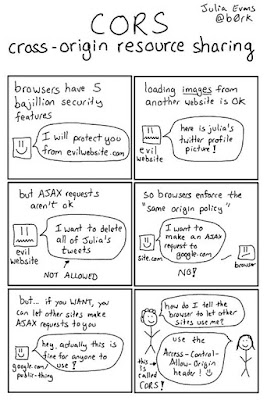I've decided to pursue the CISSP certification! The CISSP is considered the gold standard of Information Security credentials, and is required by some of the world's most security-conscious organizations. It assures that InfoSec leaders possess the breadth of knowledge, skills and experience required to credibly build and manage the security posture of an organization. It will be a great challenge to prepare for the exam and pass it, but the subject matter is something that I am exposed to every day at work, so hopefully that will give me an advantage.
/**
* eubanks.dev
*/
Saturday, November 21, 2020
Thursday, July 23, 2020
Thursday, April 9, 2020
Today my team configured AWS CloudTrail to deliver log files to an S3 bucket. This required us to attach a specific S3 bucket policy to the bucket:
{
"Version": "2012-10-17",
"Statement": [
{
"Sid": "AWSCloudTrailAclCheck20150319",
"Effect": "Allow",
"Principal": {"Service": "cloudtrail.amazonaws.com"},
"Action": "s3:GetBucketAcl",
"Resource": "arn:aws:s3:::myBucketName"
},
{
"Sid": "AWSCloudTrailWrite20150319",
"Effect": "Allow",
"Principal": {"Service": "cloudtrail.amazonaws.com"},
"Action": "s3:PutObject",
"Resource": "arn:aws:s3:::myBucketName/[optional prefix]/AWSLogs/myAccountID/*",
"Condition": {"StringEquals": {"s3:x-amz-acl": "bucket-owner-full-control"}}
}
]
}
Wednesday, November 20, 2019
Today I used Amazon Athena
Today I used Amazon Athena to convert load balancer logs in an S3 bucket to a database table so I could write SQL queries against it and find specific HTTP requests that came in at a specific time!
Tuesday, November 19, 2019
Friday, October 11, 2019
AWS SysOps Administrator Associate exam coming up
In a month I am scheduled to take the AWS SysOps Administrator Associate certification exam. I hear that this cert is widely regarded as the most difficult of the associate-level AWS certs...so it's going to be a tough one! I'm hoping that my 18 months of hands-on experience working in AWS and my ACG subscription will carry me through...😬
Wednesday, October 9, 2019
Using AWS to host a static site over SSL
If you have an S3 bucket configured to host a static website and you want users to access this website via a domain (hosted zone) you have procured in Route53, it's pretty straightforward. HOWEVER, if you want that website to be accessible over SSL, it gets way more complicated and have to correctly integrate 4 different AWS services!
S3 — for storing the static site
CloudFront — for serving the static site over SSL
AWS Certificate Manager — for generating the SSL certificates
Route53 — for routing the domain name to the correct location
It's way more difficult than I initially thought and it took much longer than expected to get it working.
Saturday, September 28, 2019
Creating SAML test SP and IdP using free online tools
This week I found free, online SAML Service Provider (SP) and Identity Provider (IdP) tools and integrated them together to get a working, SP-initiated SAML authentication workflow for us to test SSO in our mobile apps.
IdP: https://samltest.id/
Wednesday, July 31, 2019
Cybersecurity: Read Team vs. Blue Team
Should a company investing in building an offensive security "Red Team" so they can skillfully discover vulnerabilities in their systems, or a "Blue Team" so they can skillfully react and even prevent those vulnerabilities?
There is no “red team is better than blue,” no benefit to picking sides or investing in only one. The important thing is remembering that the goal of both sides is to prevent cyber crimes.One idea born out of trying to reconcile red and blue teams is the creation of purple teams. Purple teaming is a concept that does not truly describe the existence of a brand new team, it’s rather a combination of both the red team and blue team. It engages both teams to work together.
Thursday, July 18, 2019
Automated deployment of IDS/IPS agent via Ansible
Today I automated the deployment of an IDS/IPS agent to several AWS intances using Ansible's script module
Friday, June 14, 2019
Tuesday, May 28, 2019
Wednesday, May 8, 2019
Using AWS SNS to send SMS directly to phone number
Friday, March 15, 2019
Burp Suite

Wednesday, March 13, 2019

Simplified instructions for updating an SSL certificate for Tomcat:
Part 1 - Generating the artifacts (.jks, .csr, .cer/.crt)
- Use Java's keytool -genkey program to generate a new private key and store it in a keystore (.jks file)
- This is where you'll be asked for the information that your future Certificate Signing Request (CSR) should contain, such as domain name, company name, city, state, etc.
- Use Java's keytool program to generate a Certificate Signing Request (CSR) referencing the private key created in the previous step.
- Go to the domain registrar's website to purchase the new SSL certificate from the partnering Certificate Authority (CA) and use their web UI to start the activation process.
- During the activation process, you'll be asked to paste the contents of the CSR file created in a previous step. The CA will review this and decide whether or not to issue you an SSL Certificate file (.crt or .cer file).
- Upon approval, you will be emailed the SSL Certificate file and must upload this to the web server.
Part 2 - Installation
- Use Java's keytool -import program to import the SSL Certificate file (.crt or .cer file) into the previously created keystore (.jks file)
- Use Java's keytool -list program to validate the imported certificate
- Modify Tomcat's server.xml to reference the new keystore (.jks file)
- Restart Tomcat and use Digicert's SSL Certificate Checker tool to validate the SSL cert from a third party
- https://www.digicert.com/help/

#!/bin/bash
server=challenge01.root-me.org
port=80
while read url
do
echo -ne "$url\t"
echo -e "GET /$url HTTP/1.0\nHost: $server\n" | netcat $server $port | head -1
done | tee outputfile
Tuesday, March 12, 2019
Becoming a hacker to prevent getting hacked

Tuesday, March 5, 2019

Monday, March 4, 2019
Friday, March 1, 2019

For anyone who is considering building a mobile app using a cross-platform or hybrid framework such as React Native, Ionic, or Kony, keep in mind that debugging a memory leak can be very difficult! I've been tracking down the source of a slow memory leak that's causing the Android version of our Kony app to crash if the user camps out on a particular screen for an hour or two. The logcat backtrace and tombstone info really just tells me "something went wrong when the Kony API was called". One of many tradeoffs with cross-platform frameworks.
Subscribe to:
Comments (Atom)















